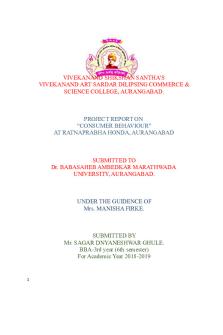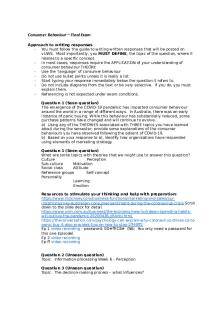Consumer behaviour PDF

| Title | Consumer behaviour |
|---|---|
| Author | Patrica Lesely |
| Course | Management Dynamics |
| Institution | Western Sydney University |
| Pages | 17 |
| File Size | 1.1 MB |
| File Type | |
| Total Downloads | 51 |
| Total Views | 193 |
Summary
These are lecture notes for consumer behaviour for final exam...
Description
Situational influences, Decison-making, Problem Recognition and Information Search What is a consumer situation? set of factors outside of, and removed from, the individual consumer, as well as removed from the characteristics of the stimulus object … to which the consumer is reacting or temporary environmental factors that form the context within which a consumer activity occurs at a particular place and time.
Situational Factors ● -
In order to utilise situational factors marketer’s must understand: When a particular situation affects consumer behaviour How strong the effect is? The way in which the situation influences behaviour
Types of situations -
Communication situation: The situation in which consumers receive information Purchase situation: The situation in which purchase occurs Usage situation: The situation in which a product is being used Disposal situation: The situation in which products are disposed Ritual situation: Structured, interrelated behaviours, socially defined occasions and Symbolic meaning
Dimensions of situations (Belk 1980) -
Physical surroundings Social surroundings Temporal (time) perspective Task definition Antecedent states
Physical surroundings The concrete and spatial aspects of the environment. -
Casinos Effects of music on shoppers Part of the 7Ps – Physical Evidence
-
Effects of music on shoppers Effects of crowding on shoppers Effects of store location Store layout Atmospherics
Influence of physical density on shoppers
Social Surroundings -
The effects of other people in a consumption situation. Consider group influence.
Temporal influence -
Individual’s concept of time: Relativity, eating before an event, Eating as the event, = Time as a product benefit Time as a situational variable- the availability of time. Can also relate to time of day, time of year (e.g. season), or an event.
Task definition -
The reason people buy and consume. (why) Closely related to usage situation. E.g. gift giving, purchasing clothes (general task) and Purchasing clothes online (specific task).
Antecedent states -
Temporary physiological and mood states. Can include resources ‘state’ (e.g. money). Can lead to problem recognition.
Situational influence and marketing strategy -
Segmentation Advertising
-
Positioning Product development Distribution
Use situations and product position
Purchasing Process -
What to buy When to buy Where to buy How to buy
Consumer Decision process
Decision process
Problem recognition- perceived difference between ideal and actual state of affairs - Search- Seek relevant information about potential solutions to the problem from external environment, or activate knowledge from memory - Evaluation- Evaluate or judge alternatives in terms of salient beliefs about relevant consequences and combine this knowledge to make a choice - Selection- Buy the chosen alternative - Post purchase- Use the alternative and evaluate it again in light of its performance
Involvement and types of Decision Making
Problem Recognition Definition: is the result of discrepancy between a desired state and an actual state that is sufficient to arouse and activate the decision process.
Desire to resolve problem depends on: 1. magnitude of discrepancy between desired and actual states: eg may want a car with power windows but desire not so great to get action 2. relative importance of the problem: eg buying a new car important but not as important as buying a house, electricity or food ● Consumer can be aware of the existence of a problem “active problem” or unaware “inactive problem” eg having BO - must be aware of a problem before will fix it Non-marketing factors affecting problem recognition
Delays to Problem Recognition - Discrepancy not sufficiently large Outside realm of consumer activity - Deny the discrepancy Lack of problem definition Constraints - Caution - Not sure how purchase will solve problem Problem Recognition -
In Fine Dining, is hunger the problem/need? Or is it part of the currency? Is it the antecedent? Could it merely be considered a prerequisite? Like getting there on time, or wearing the appropriate clothes? Eg. ‘Come hungry
Marketing implications -
Activating problem recognition: influencing desired state, influencing perceptions of actual state, [notes] Removing delays in problem recognition
-
Better marriage blanket
Information Search
Types of Information Sought -
Alternative brands available Evaluative criteria to compare brands Importance of evaluative criteria How each alternative performs on each evaluative criterion?
Categories of decision alternatives
Sources of information
Perceived costs and benefits determine the search effort
Factors that influence external information search -
Market characteristics: number of alternatives, price range, store distribution, information availability, marketing communication, other Product characteristics: a, price level product differentiation, positive products Consumer characteristics: Learning/knowledge and experience, social status, demographic profile, perceived risk, shopping orientation Situational characteristics
Marketing strategies based on information- search patterns 1. Maintenance strategy: maintain habitually brand purchase by target market Disrupt strategy: disrupt decision process where brand is not part of the evoked set and target market habitually purchases. 2. Capture strategy: limited decision making at point-of-purchase based on few criteria. Capture based on criteria. - Intercept strategy: limited decision making and brand not part of evoked set. Intercept the consumer during search. 3. Preference strategy: extensive decision making with brand in evoked set - Acceptance strategy: extensive decision making with brand not in evoked set. Alternative Evaluation, Purchase and Post-Purchase Behaviour
Alternative evaluation and selection process
Evaluation Criteria Definition: are the various features a consumer looks for in response to a particular type of problem They vary in: -
Type: tangible/objective and intangible/subjective Number Importance
Individual judgements Some key concepts related to individual judgments:
-
Sensory discrimination Just-noticeable difference Surrogate indicators: Predictive value, Confidence value Eg price, brand
Decision Rules 1. Conjunctive: Brands that meet a minimum level on each evaluative criterion 2. Disjunctive: Brands that meet a satisfactory level on any relevant evaluative criteria 3. Elimination by-aspects: Rank brands on evaluative criteria and select highest ranking brands until only one is left 4. Lexicographic: Rank brands on evaluative criteria importance and select the one that is highest on most important criteria 5. Compensatory: select brand that has the highest score over all the relevant evaluative criteria 6. Experiential Choice processes: Brand-loyal purchases, Affect-referral heuristic and Impulse purchases Hypothetical application of decision rules in choosing a video camera
Marketing strategy and Decision Rules
Outlet Selection What is a retail outlet? -
any source of products or services for consumers A retail outlet is a “space” for any type of seller transacting with a consumer
Which comes first: Outlet or brand selection? Under what circumstances is outlet selection most likely to influence brand choice? -
When store loyalty is high When brand loyalty is low When brand information is inadequate
Factors affecting outlet selection CHARACTERISTICS OF THE OUTLET: -
Outlet image Store brands Retail advertising Outlet location and size
CHARACTERISTICS OF THE CONSUMER: -
Motivation to shop Shopping orientation Perceived Risk
Dimensions and components of outlet image
Factors affecting outlet selection CHARACTERISTICS OF THE OUTLET: -
Outlet image Store brands Retail advertising: Media, Price-oriented advertising and Image-oriented advertising Outlet location and size: o Geographic location (closest if no other considerations) o Size (largest, if no other considerations) o Travel to a store takes both physical and psychological effort, and willingness to travel will vary by product category.
Characteristics of the consumer Motivations to shop
CHARACTERISTICS OF THE CONSUMER: -
Motivation to shop Shopping orientation: An individual’s style of shopping or general attitudes towards shopping. Which one are you??? Perceived Risk o Financial risk o Performance risk o Time-loss risk o Physical risk o Psychological o Opportunity loss o Social risk
In-store influences that impact on evaluation of alternatives and purchase
Purchase
Traditionally used: -
Cash personal cheques lay-by
Trend to “Cashless society” facilitated by: -
Automatic teller machines (ATM) Electronic funds transfer at point of sale (EFTPOS) Telephone banking Internet purchasing Prepaid payment cards Credit cards
Post purchase Processes Post-purchase processes are the thoughts, feelings and behaviours that occur after a consumer transaction. Purchase Behaviour
Postpurchase Dissonance What is it? Buyer’s remorse
-
Doubt or anxiety post-purchase decision
When is it more likely to occur? -
minimum threshold of dissonance tolerance is passed action is irrevocable decision is extremely important unselected alternatives have desirable features several alternatives are desirable available alternatives attributes are dissimilar buyer has high degree of commitment to the decision no pressure is applied to consumer to purchase person has an anxious personality
How can it be reduced? -
increase desirability of purchased brand Decreased desirability of rejected alternatives Decrease the importance of the decision Reverse the decision
Product use/Non-use -
A consumption experience “is the cognitions and feelings the consumer experiences during the use of a product or service”. Product use “involves the actions and experiences that take place in the time period in which a consumer is directly experiencing a good or service”.
Additional purchases/purchase behaviour -
Related product/service purchase: customer needs to be made aware of potential products/services that exist Product set-up and use: Provide information and assistance, understand the user’s consumption system and decisions about warranties.
Disposal alternative
Purchase Evaluation: The evaluation process Satisfaction is a function of the difference between: Expectations of performance, and Perceived actual performance Expectations significantly impact perceived performance.
Purchase Evaluation: The evaluation process
Consumer actions in response to dissatisfaction
Consumer actions in response to dissatisfaction: -
86% of Aussies have abandoned a purchase and walked out of a store due to poor service (second to Mexico). - 65% always tell people about their bad service 61% have lost temper - We tell 23 people about bad service vs 10 people about good service Only Italians and Indians bemoan bad customer service to more people than Australians. - Bad service experience had the greatest impact on their impression of a company's brand. People were 50% more likely to complain to others than to the restaurant or cafe. Marketing implications of complaining behaviour - Create realistic expectations Constantly monitor product/service quality - Provide customer with adequate information Offer realistic guarantees of satisfaction Reward loyal customers Develop a system for handling complaints...
Similar Free PDFs

Consumer behaviour
- 16 Pages

Consumer behaviour
- 17 Pages

Consumer Behaviour
- 2 Pages

Notes - Summary Consumer Behaviour
- 29 Pages

Consumer behaviour 2
- 21 Pages

Consumer Behaviour Exam Notes
- 45 Pages

Consumer Behaviour Notes
- 77 Pages

Consumer Behaviour Lecture 2
- 8 Pages

Chapter 6 Consumer Behaviour
- 10 Pages

Chapter 3: consumer behaviour
- 13 Pages

Consumer Behaviour Project
- 37 Pages

Consumer Behaviour Notes
- 59 Pages

Consumer Behaviour Final Exam
- 2 Pages

CONSUMER BUYING BEHAVIOUR
- 6 Pages
Popular Institutions
- Tinajero National High School - Annex
- Politeknik Caltex Riau
- Yokohama City University
- SGT University
- University of Al-Qadisiyah
- Divine Word College of Vigan
- Techniek College Rotterdam
- Universidade de Santiago
- Universiti Teknologi MARA Cawangan Johor Kampus Pasir Gudang
- Poltekkes Kemenkes Yogyakarta
- Baguio City National High School
- Colegio san marcos
- preparatoria uno
- Centro de Bachillerato Tecnológico Industrial y de Servicios No. 107
- Dalian Maritime University
- Quang Trung Secondary School
- Colegio Tecnológico en Informática
- Corporación Regional de Educación Superior
- Grupo CEDVA
- Dar Al Uloom University
- Centro de Estudios Preuniversitarios de la Universidad Nacional de Ingeniería
- 上智大学
- Aakash International School, Nuna Majara
- San Felipe Neri Catholic School
- Kang Chiao International School - New Taipei City
- Misamis Occidental National High School
- Institución Educativa Escuela Normal Juan Ladrilleros
- Kolehiyo ng Pantukan
- Batanes State College
- Instituto Continental
- Sekolah Menengah Kejuruan Kesehatan Kaltara (Tarakan)
- Colegio de La Inmaculada Concepcion - Cebu

